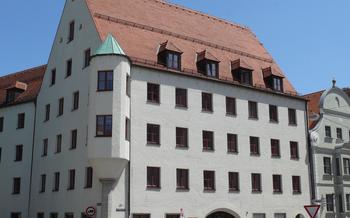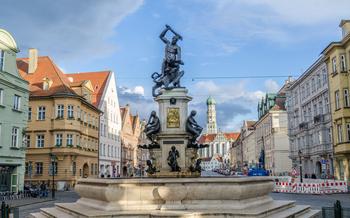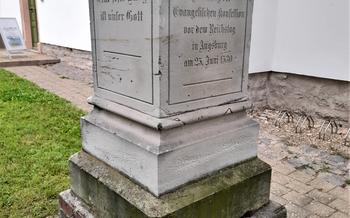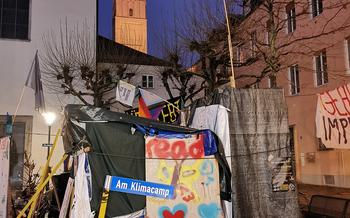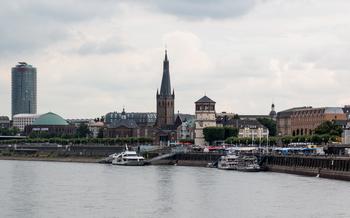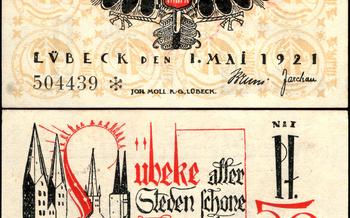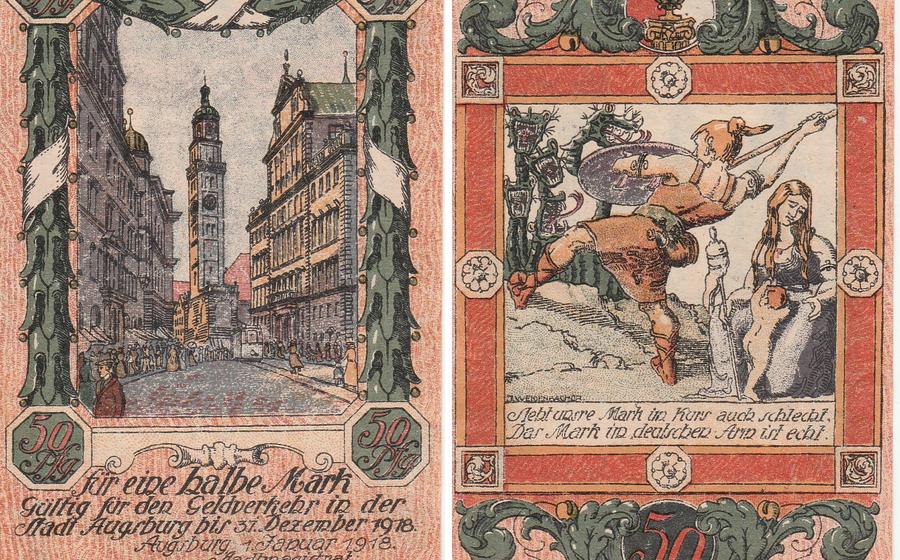
Fir Tree Tower (Fichtenturm)
- A Monumental Entrance to Augsburg’s Old Town
- The History of the Fir Tree Tower
- Exploring the Tower’s Exterior
- The Tower's Unique Name
- The Role of the Fichtenturm in Augsburg’s Defense
- Panoramic Views from the Tower’s Observation Deck
- Exhibits and Displays Inside the Tower
- Legends and Folklore Surrounding the Tower
- The Tower’s Role in Augsburg’s Cultural Life
- The Fichtenturm as a Symbol of Augsburg
- Restoration and Preservation Efforts
- Visiting the Fir Tree Tower: Practical Information
- Nearby Attractions and Activities
- Insider Tip: The Best Time to Visit
A Monumental Entrance to Augsburg’s Old Town
The Fichtenturm, or Fir Tree Tower, stands as a majestic gateway to the enchanting Old Town of Augsburg, Germany. This imposing structure, dating back to the 15th century, is a testament to the city’s rich history and architectural prowess. With its distinctive facade adorned with intricate carvings and inscriptions, the tower proudly welcomes visitors into the heart of Augsburg's Altstadt, beckoning them to explore its captivating streets and hidden treasures.
Located at the western edge of the Old Town, the Fichtenturm is easily accessible on foot or by public transportation. The tower's strategic position, overlooking the city's historic canals and fortifications, offers a glimpse into the city's past as a thriving trading hub and a significant defensive stronghold. In the vicinity of the tower, visitors can find themselves surrounded by an array of captivating attractions, including the medieval Town Hall, the Perlachturm, and the picturesque canals that weave their way through the city center.
The History of the Fir Tree Tower
The Fichtenturm's origins can be traced back to the 12th century, when it was constructed as part of Augsburg's medieval fortifications. Initially, it served as a watchtower, allowing guards to keep a vigilant eye on the surrounding area and alert the city of approaching threats. Over the centuries, the tower underwent several modifications and renovations, adapting to changing defense strategies and architectural styles.
In the 16th century, the tower was significantly fortified and integrated into the city's defensive walls. It was equipped with gun embrasures, allowing defenders to fire upon attackers from within the tower's protected interior. This transformation reflected Augsburg's growing importance as a trading center and its vulnerability to external threats during a tumultuous period in European history.
Despite its military significance, the Fichtenturm also played a vital role in the city's civilian life. It served as a storage facility for gunpowder and other supplies, ensuring the city's readiness for potential conflicts. Additionally, the tower's height and strategic location made it an ideal platform for public announcements and proclamations, reaching a wide audience across the city.
Exploring the Tower’s Exterior
The Fir Tree Tower stands as a testament to the architectural prowess of the Medieval era. Its exterior boasts a harmonious blend of Gothic and Renaissance elements. The facade is adorned with intricate carvings and decorative details, showcasing the artistic skills of the craftsmen who built it. The tower’s height, standing at an impressive 72 meters, makes it a prominent landmark visible from afar. Its imposing presence and unique architectural features leave visitors in awe, inviting them to discover the stories held within its walls.
At the base of the tower, visitors can marvel at the intricate carvings that adorn the entrance. These carvings depict scenes from the Bible and the lives of saints, offering a glimpse into the religious beliefs of the time. The tower’s height offers a commanding view of Augsburg’s cityscape. Visitors can enjoy panoramic vistas that encompass the city’s historic landmarks, including the Augsburg Cathedral and the Town Hall. The tower’s strategic location provides a unique perspective for capturing stunning photographs, allowing visitors to immortalize their memories of this architectural masterpiece.
The Tower's Unique Name
The Fir Tree Tower has borne its distinctive name, "Fichtenturm," for centuries. The exact origin of the name is shrouded in the mists of time, but several historical anecdotes and legends offer intriguing explanations.
One popular tale attributes the name to a fir tree that once stood near the tower. According to the legend, the tree was planted as a symbol of peace and prosperity and became a beloved landmark in its own right. Over time, the tower became known as the "Fir Tree Tower," forever linking it to the tree that stood beside it.
Another theory suggests that the name may have originated from the appearance of the tower's roof. The original roof was constructed using wooden shingles, which gave it a distinctive texture and appearance reminiscent of a fir tree's needles. This resemblance may have inspired the name "Fichtenturm," which aptly captures the essence of the tower's unique architectural feature.
Regardless of its exact origins, the name "Fir Tree Tower" has become an integral part of Augsburg's cultural heritage. It is a name steeped in history, folklore, and local pride, reflecting the tower's deep connection to the city and its people.
Despite its widespread use, the tower has also been known by other names throughout history. In some older documents, it is referred to as the "Watchtower" or the "Defense Tower," highlighting its original purpose as a strategic vantage point for guarding the city. However, the name "Fir Tree Tower" has endured as the most popular and enduring moniker, symbolizing the tower's unique identity and its enduring place in Augsburg's history.
The Role of the Fichtenturm in Augsburg’s Defense
Augsburg’s strategic location at the crossroads of important trade routes made it a coveted prize for various powers throughout history. The city’s wealth and prosperity attracted invaders and rivals, leading to the construction of a robust defense system to protect its citizens and assets. The Fichtenturm played a crucial role in this defensive network.
As part of the city walls and fortifications, the tower served as a watchtower, allowing sentries to keep a vigilant eye on the surrounding landscape. Its elevated position provided an unobstructed view of approaching armies, enabling the city to prepare for potential attacks. In times of conflict, the tower’s thick walls and sturdy construction provided shelter and protection for soldiers defending the city.
The tower’s strategic placement allowed it to coordinate with other defensive structures, such as gates, towers, and bastions, forming a formidable defensive system. This network of fortifications helped Augsburg withstand numerous sieges and invasions throughout its history, including attacks by the Swedish army during the Thirty Years’ War.
The tower’s contribution to Augsburg’s defense extended beyond its physical role. Its symbolic significance as a symbol of strength and resilience bolstered the morale of the city’s inhabitants, reminding them of their ability to withstand adversity and protect their cherished city.
Panoramic Views from the Tower’s Observation Deck
The highlight of a visit to the Fir Tree Tower is undoubtedly the breathtaking panorama that unfolds from its observation deck, offering visitors a unique perspective of Augsburg and its surroundings. As you ascend the tower’s steep staircase, anticipation builds, and upon reaching the top, you are greeted with an awe-inspiring vista that stretches far and wide.
The observation deck encircles the tower, providing unobstructed views in every direction. To the north, the majestic Augsburg Cathedral dominates the skyline, its Gothic spires piercing the sky. In the foreground, the city’s red-tiled rooftops create a vibrant tapestry, while the tree-lined canals meander through the urban landscape, adding a touch of tranquility.
To the south, the horizon is marked by the foothills of the Bavarian Alps, their snow-capped peaks glistening in the distance. On a clear day, you can even catch a glimpse of the Zugspitze, Germany’s highest mountain. Turning your gaze eastward, you will be captivated by the vast expanse of the Bavarian countryside, dotted with charming villages and lush forests.
The observation deck is equipped with informative panels that help visitors identify key landmarks and points of interest. Whether you are a history buff, an architecture enthusiast, or simply someone who appreciates stunning views, the Fir Tree Tower’s observation deck promises an unforgettable experience.
Exhibits and Displays Inside the Tower
The Fir Tree Tower houses a fascinating collection of exhibits and displays that delve into the rich history and cultural significance of Augsburg. As you ascend the tower, you will encounter a series of informative panels and interactive displays that showcase various aspects of the city’s past.
Historical artifacts and documents related to the tower’s construction, use, and modifications are carefully preserved and presented. These include original blueprints, photographs, and records that provide insights into the tower’s evolution over the centuries.
Interactive exhibits allow visitors to engage with Augsburg’s history in a dynamic and immersive way. Through touchscreens and multimedia presentations, you can explore the city’s timeline, learn about its notable figures, and discover hidden stories that have shaped its identity.
Thematic displays highlight specific aspects of Augsburg’s history and culture. One exhibit focuses on the city’s role as a center of trade and commerce, showcasing artifacts from its bustling markets and merchant guilds. Another exhibit explores Augsburg’s artistic and cultural heritage, featuring replicas of famous paintings, sculptures, and musical instruments.
The educational value of these exhibits is immense, catering to visitors of all ages and interests. Whether you are a history buff, a culture enthusiast, or simply curious about Augsburg’s past, you will find something to captivate and inform you within the tower’s walls.
Legends and Folklore Surrounding the Tower
The Fir Tree Tower has inspired a rich tapestry of legends and folklore that have been passed down through generations. One popular tale speaks of a ghostly figure that haunts the tower, said to be the spirit of a former watchman who met an untimely demise while on duty. Visitors who dare to climb the tower at night claim to have heard eerie footsteps and disembodied voices echoing through the centuries-old walls.
Another legend tells of a hidden treasure buried beneath the tower, said to have been amassed by a wealthy merchant in the Middle Ages. Despite countless attempts to locate the treasure, it remains undiscovered, fueling speculation and intrigue among locals and visitors alike.
These legends and stories have woven themselves into the cultural fabric of Augsburg, adding an aura of mystery and enchantment to the Fir Tree Tower. They have helped shape the city's identity and continue to captivate the imaginations of those who visit this historic landmark.
The Tower’s Role in Augsburg’s Cultural Life
The Fichtenturm is not just a historical landmark but also an active participant in Augsburg’s vibrant cultural landscape. Its unique setting and rich history make it a sought-after venue for a variety of cultural events and exhibitions. The tower’s spacious interior and versatile layout can accommodate a diverse range of events, from intimate concerts and performances to larger-scale festivals and exhibitions.
One of the highlights of the cultural calendar is the annual “Fichtenturm Festival,” a week-long celebration showcasing the city’s rich history, traditions, and diverse cultural offerings. The festival transforms the tower and its surroundings into a vibrant stage, hosting concerts, performances, historical reenactments, and themed markets. Visitors can immerse themselves in Augsburg’s past and experience the city’s cultural diversity firsthand.
Throughout the year, the Fichtenturm also hosts a range of temporary exhibitions, showcasing the work of local artists, highlighting aspects of Augsburg’s history, or exploring various cultural themes. These exhibitions provide a platform for local talent and offer visitors an opportunity to delve deeper into the city’s cultural heritage.
By hosting these cultural events and exhibitions, the Fichtenturm plays a vital role in fostering Augsburg’s vibrant cultural scene and providing a platform for artistic expression and community engagement. It is a testament to the tower’s enduring significance as a symbol of the city’s cultural vitality and its commitment to preserving and celebrating its rich heritage.
The Fichtenturm as a Symbol of Augsburg
The Fichtenturm, with its imposing presence and historical significance, stands as a proud symbol of Augsburg's rich history and heritage. It represents the city's resilience and strength, having withstood numerous challenges and changes over the centuries. The tower's unique architectural features and strategic location have made it an iconic landmark that is deeply cherished by local residents.
The Fichtenturm has become a symbol of Augsburg's identity, deeply embedded in the city's culture and traditions. It is often depicted in art, literature, and popular culture as a representation of the city's spirit and character. This iconic tower serves as a constant reminder of Augsburg's rich past and its enduring significance in the present day.
Restoration and Preservation Efforts
The Fichtenturm has stood the test of time, but it has not been without challenges. The ravages of weather, pollution, and age have taken their toll on the tower's exterior and structure. Recognizing the importance of preserving this iconic landmark, the city of Augsburg has undertaken a series of restoration and conservation projects. These projects have involved meticulous cleaning and repair work, as well as structural reinforcement to ensure the tower's long-term stability.
One of the most significant challenges has been addressing the deterioration of the tower's sandstone facade. Over time, the stone has become eroded and weathered, leading to cracks and gaps. Skilled craftsmen have painstakingly repaired these damaged areas, using traditional techniques and materials to maintain the tower's original appearance.
In addition to the exterior restoration, the tower's interior has also been subject to conservation efforts. The wooden staircase, which has borne the weight of countless visitors over the centuries, has been carefully restored to ensure its safety and integrity. The tower's roof, which protects the interior from the elements, has also been repaired and strengthened.
These restoration and preservation efforts are essential to ensuring that the Fir Tree Tower continues to stand proudly as a symbol of Augsburg's rich history. The city's commitment to preserving this iconic landmark demonstrates the importance it places on its cultural heritage and the desire to share it with future generations.
Visiting the Fir Tree Tower: Practical Information
Opening hours and admission fees:
- The Fir Tree Tower is open to the public during specific hours, typically from 10:00 AM to 5:00 PM, with extended hours during peak tourist seasons.
- Admission fees are usually charged, with discounted rates for students, seniors, and groups. Check the official website for current pricing information.
Guided tours and self-guided exploration options:
- Guided tours of the Fir Tree Tower are available, providing visitors with insights into the history, architecture, and significance of the tower.
- Visitors can also opt for self-guided exploration, allowing them to explore the tower at their own pace and take in the sights and information at their leisure.
Accessibility for visitors with disabilities:
- The Fir Tree Tower is wheelchair accessible, with ramps and elevators available to facilitate access for visitors with mobility challenges.
- Visitors with disabilities are encouraged to contact the tower's management in advance to ensure a smooth and enjoyable visit.
Facilities available for visitors’ convenience:
- Restrooms are available on-site for the convenience of visitors.
- A small gift shop is located at the base of the tower, offering souvenirs, postcards, and other mementos of the Fir Tree Tower and Augsburg.
Nearby Attractions and Activities
Augsburg offers a wealth of attractions and activities for visitors to explore. After taking in the grandeur of the Fir Tree Tower, consider venturing further into the heart of Augsburg's Old Town. Stroll along the picturesque cobblestone streets, admiring the medieval architecture and colorful facades of the buildings that line the way. Visit the town hall, a masterpiece of Renaissance architecture, and marvel at the intricate details of its facade.
Augsburg is home to several museums that offer insights into the city's rich history and culture. The Augsburg City Museum showcases the city's development from its Roman origins to the present day. The Schaezler Palace houses a collection of art and antiques, providing a glimpse into the opulent lifestyle of the city's wealthy elite. For those interested in religious art, the Diocesan Museum displays a stunning collection of medieval and Baroque masterpieces.
Take a leisurely stroll along the city's canals, a tranquil oasis amidst the urban bustle. Cross the picturesque bridges, admire the reflections of the buildings in the water, and enjoy the serenity of the surroundings. The canals are a popular spot for boat tours, offering a unique perspective of the city from the water.
Indulge in a culinary adventure by sampling the local delicacies at one of Augsburg's many restaurants. From traditional Bavarian cuisine to international fare, there's something to satisfy every palate. Be sure to try the city's signature dish, Schäufele, a slow-roasted pork shoulder served with dumplings and sauerkraut.
Augsburg's vibrant city center offers a range of shopping opportunities. From high-end boutiques to charming local shops, there's something for every taste and budget. Explore the narrow alleys and courtyards, discovering hidden gems and unique finds along the way.
Insider Tip: The Best Time to Visit
Plan for a Sunrise or Sunset Visit: Experience the magic of Augsburg’s cityscape bathed in the warm hues of sunrise or sunset. These times offer breathtaking photo opportunities and a serene ambiance.
Avoid Peak Tourist Season: Steer clear of the summer months (July and August) when tourist crowds can be overwhelming. Consider visiting during the shoulder seasons (spring and fall) for a more relaxed and enjoyable exploration.
Choose a Clear Day: Favor clear weather conditions to maximize your viewing pleasure from the tower's observation deck. Crisp, blue skies provide unobstructed vistas and enhance the vibrancy of the city's landmarks.
Capture the Tower's Reflections: Visit on a day with a light breeze to witness the tower's reflection shimmering on the surface of the nearby canals. This picturesque sight adds an extra layer of charm to your photographs.
Attend a Cultural Event: Check the tower's event calendar for upcoming cultural events, concerts, or exhibitions. These occasions offer a unique opportunity to experience the tower's vibrant atmosphere and delve deeper into Augsburg's rich cultural heritage.
